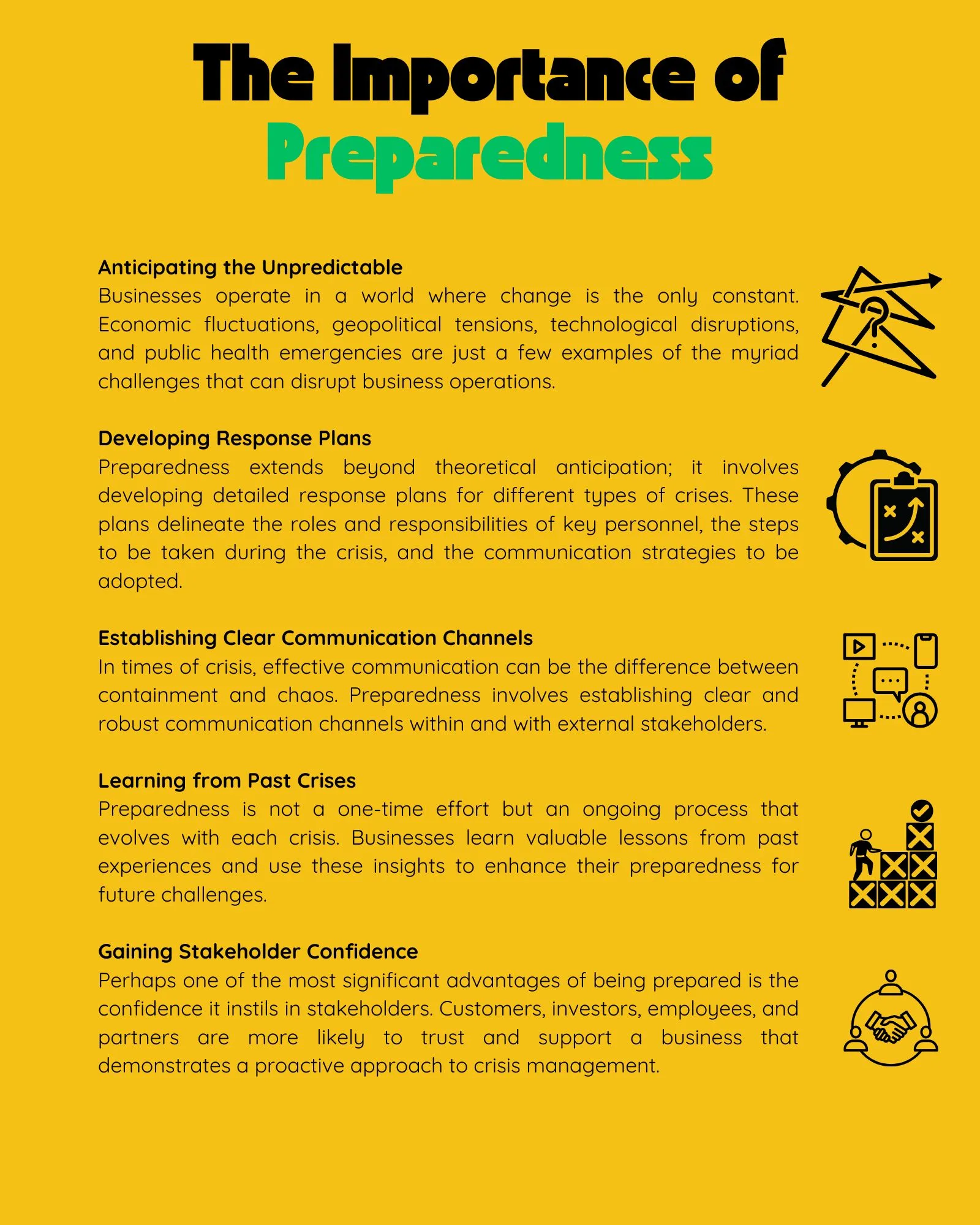- Table of Contents
- Introduction
- Understanding Business Crises
- The Importance of Preparedness
- Anticipating the Unpredictable
- Developing Response Plans
- Establishing Clear Communication Channels
- Learning from Past Crises
- Gaining Stakeholder Confidence
- Key Steps to Survive a Crisis
- 1. Assess the Situation
- 2. Communicate Effectively
- 3. Adapt and Innovate
- 4. Prioritise and Streamline Operations
- 5. Manage Cash Flow
- 6. Build Strong Relationships
- 7. Invest in Employee Well-being
- 8. Leverage Technology
- 9. Explore New Market Opportunities
- 10. Maintain a Positive Outlook
- The Role of Social Media in Crisis Communication
- Rapid Dissemination of Information
- Engaging with Stakeholders
- Transparency and Authenticity
- Crisis Monitoring and Sentiment Analysis
- Addressing Misinformation and Rumors
- Crisis Preparedness Campaigns
- Coordinated Crisis Response
- Humanising the Brand
- Crisis Simulation and Training
- Post-Crisis Communication and Reputation Management
- Psychological Resilience in Business Leadership
- Emotional Intelligence and Empathy
- Decision-Making Under Pressure
- Optimism and Vision
- Effective Communication
- Stress Management and Self-Care
- Adaptability and Learning
- Work-Life Balance Advocacy
- Resilience Training and Support Systems
- Crisis Leadership Training
- Celebrating Small Wins and Acknowledging Efforts
- Conclusion
Introduction
In the ever-evolving landscape of business, crises are inevitable. Whether it's an economic downturn, a natural disaster, or a global pandemic, these challenges can severely impact the survival of businesses. However, with the right strategies and a proactive mindset, it is possible not only to survive, but also to thrive in times of crisis. This article presents 10 key steps that businesses can take to weather the storm and emerge stronger on the other side.
Understanding Business Crises
Before diving into the strategies, it's essential to understand what constitutes a business crisis. A crisis is an event or a series of events that disrupts regular business operations and poses a threat to its survival. Crises can vary in nature and severity, but they all share a common need for effective management and decision-making.
The Importance of Preparedness
One of the fundamental pillars of surviving a crisis is preparedness. Businesses that have invested time and resources in contingency planning and risk assessment are better equipped to navigate uncertain times. During the year 2019, and before the COVID-19 pandemic hit, 95% of participants in a PwC survey expressed their anticipation of an impending crisis within the subsequent two years. However, when the pandemic unfolded in 2020, only 30% of those participants indicated that they had established a crisis management team in position in another survey that PwC conducted in 2021.

Which is when the effectiveness of being prepared comes in. By anticipating potential threats, developing response plans, and establishing clear communication channels, companies can minimise the impact of a crisis and ensure a more seamless recovery. Let’s delve deeper into these:
Anticipating the Unpredictable
Businesses operate in a world where change is the only constant. Economic fluctuations, geopolitical tensions, technological disruptions, and public health emergencies are just a few examples of the myriad challenges that can disrupt business operations. Anticipating these challenges is not a luxury but a necessity. Preparedness begins with a rigorous analysis of historical data, market trends, and global events. It involves scenario planning, where businesses simulate various crisis scenarios to identify vulnerabilities and devise appropriate responses. Businesses can proactively implement preventive measures by foreseeing potential threats, making them far more resilient when a crisis strikes.
Developing Response Plans
Preparedness extends beyond theoretical anticipation; it involves developing detailed response plans for different types of crises. These plans delineate the roles and responsibilities of key personnel, the steps to be taken during the crisis, and the communication strategies to be adopted. For instance, a response plan for a cyber-attack would differ significantly from a plan designed to manage a natural disaster. Such plans act as guiding documents, ensuring everyone in the organisation knows what to do when confronted with a crisis. Regular drills and simulations are conducted to test the efficacy of these plans, allowing businesses to refine their strategies and plug potential loopholes.
Establishing Clear Communication Channels
In times of crisis, effective communication can be the difference between containment and chaos. Preparedness involves establishing clear and robust communication channels within and with external stakeholders. Internally, employees need to be informed promptly and clearly about the situation, the steps being taken, and how it might affect them. Externally, customers, suppliers, shareholders, and the public need to receive timely and accurate information to maintain trust and confidence. Social media, websites, email newsletters, and traditional media outlets are all part of the communication arsenal. The tone of communication during a crisis should be empathetic, transparent, and reassuring, instilling confidence in the organisation's ability to manage the situation.
Learning from Past Crises
Preparedness is not a one-time effort but an ongoing process that evolves with each crisis. Businesses learn valuable lessons from past experiences and use these insights to enhance their preparedness for future challenges. Post-crisis evaluations, commonly known as debriefs, are conducted to assess the effectiveness of the response strategies employed. These evaluations identify what worked well and what didn't, enabling businesses to refine their plans and make them more robust. Additionally, businesses also learn from the experiences of others. Studying how other organisations managed similar crises provides valuable benchmarks and best practices that can be incorporated into their own preparedness strategies.
Gaining Stakeholder Confidence
Perhaps one of the most significant advantages of being prepared is the confidence it instils in stakeholders. Customers, investors, employees, and partners are more likely to trust and support a business that demonstrates a proactive approach to crisis management. This confidence is not only a reflection of the organisation's capability to handle crises but also of its commitment to the well-being of its stakeholders. Preparedness, therefore, becomes a powerful tool for building and maintaining strong relationships, which are invaluable during times of crisis.
In short, the importance of preparedness cannot be emphasised enough. It is the shield that businesses wield against the uncertainties of the future. By investing in preparedness, businesses enhance their ability to survive crises and position themselves to emerge stronger, more resilient, and better prepared for the challenges of tomorrow. Preparedness is not just a strategy; it is a mindset—a commitment to adaptability, foresight, and the well-being of all those associated with the business.
Key Steps to Survive a Crisis
In the tumultuous business world, survival during a crisis necessitates a strategic approach grounded in adaptability and resilience. The following key steps outline a comprehensive framework that empowers businesses not only to weather the storm but also to emerge stronger and more agile:
1. Assess the Situation
Assessing the crisis situation is the foundational step in effective crisis management. Businesses must gather data comprehensively to understand the crisis's nature, scope, and potential impacts. This analysis allows for informed decision-making, guiding the allocation of resources and efforts. Regular updates and continuous monitoring are crucial, enabling businesses to adapt their strategies based on real-time information. Whether it's a natural disaster affecting supply chains or a pandemic disrupting consumer behaviour, a thorough understanding of the crisis landscape forms the bedrock for all subsequent actions.
2. Communicate Effectively
Effective communication is the lifeblood of crisis management. Transparent, timely, and empathetic communication with employees, customers, suppliers, and the wider community is paramount. Clarity in messaging, coupled with regular updates, fosters trust and confidence. Employees need assurance, customers seek reliability, and stakeholders demand transparency. A strong communication strategy maintains credibility, ensuring that everyone involved understands the measures being taken and the progress being made. In the digital age, social media platforms are powerful tools for disseminating information, addressing concerns, and countering misinformation.
3. Adapt and Innovate
Crises demand adaptability. Businesses must be willing to pivot existing strategies, explore new markets, and innovate their products or services. This adaptability can be a potent competitive advantage. For instance, during the COVID-19 pandemic, many restaurants shifted to online delivery and takeaway services, showcasing the power of adaptability. Innovation in service delivery, product design, or operational efficiency opens new avenues for growth. Embracing change ensures survival and positions businesses to thrive in the evolving marketplace.
4. Prioritise and Streamline Operations
In times of crisis, focusing on essential operations is paramount. Businesses must identify core objectives and streamline operations to conserve resources and maintain stability. Non-essential activities may need to be temporarily suspended. By reallocating resources toward critical functions, businesses optimise their efforts, ensuring that energy and funds are directed where they are needed most. This laser focus enhances agility, enabling swift responses to changing circumstances.
5. Manage Cash Flow
Effective cash flow management is the financial backbone of crisis survival. Businesses must meticulously assess their financial position, evaluating expenses and identifying areas for cost reduction. Common strategies include negotiating contracts, accessing government assistance programmes, and exploring alternative funding sources. Cash flow projections and scenario analyses help anticipate financial challenges, allowing businesses to implement proactive measures. By managing cash flow prudently, businesses enhance their financial resilience, ensuring they can endure prolonged periods of uncertainty.
6. Build Strong Relationships
Strong relationships with customers, suppliers, and stakeholders form a supportive network during crises. Nurturing these relationships is not only about transactions but also about mutual trust and reliability. Collaboration with suppliers can secure vital supply chains. Listening to customer feedback and adapting services based on their needs enhances loyalty. Building partnerships based on shared values and goals fosters collaboration in finding solutions. In times of crisis, this network can provide critical support, helping businesses navigate challenges collectively.
7. Invest in Employee Well-being
Employees are the backbone of any organisation, and their well-being is crucial for business resilience. During a crisis, businesses should prioritise their employees' physical and mental health, offering support systems, flexible work arrangements, and open lines of communication. In the UK, most managers acknowledge the importance of employee well-being, while only 13% have undergone mental health training. So, businesses should train their leaders to prioritise mental health in the workplace, especially during a crisis. After all, engaged and supported employees are more likely to contribute positively to the recovery efforts during turbulent times.
8. Leverage Technology
Technology plays a pivotal role in crisis management. Embracing digital tools and platforms can enable businesses to adapt their operations, facilitate remote work, and enhance efficiency. According to a study by PwC, 75% of people believe technology has played a pivotal role in enabling effective coordination among the crisis response team within their organisation. This is why embracing automation, data analytics, and cloud-based solutions can lead to improved decision-making and streamlined processes, driving business continuity.
9. Explore New Market Opportunities
Crises often reshape market dynamics, creating new opportunities. Businesses must proactively explore these shifts, identifying emerging customer needs and untapped markets. Diversifying product offerings or services caters to evolving demands. Targeting new demographics and geographic regions can reduce dependency on a single market. Business agility in identifying and capitalising on emerging trends leads to sustainable growth, making the organisation less susceptible to future shocks.
10. Maintain a Positive Outlook
Maintaining a positive outlook is not just a psychological disposition; it's a strategic choice. Crises are challenges, but they also present opportunities for growth and learning. Celebrating small victories, no matter how minor, boosts morale. Encouraging innovation and creativity instils a sense of purpose. A culture of optimism fosters resilience, enabling employees to face challenges with determination. Leaders who inspire positivity create an environment where solutions are pursued with vigour, transforming crises into catalysts for innovation and progress.
Incorporating these key steps into their crisis management strategies equips businesses to navigate the stormy seas of uncertainty. By being prepared, adaptable, and proactive, businesses survive crises and emerge stronger, more agile, and better positioned to thrive in a constantly changing world.
Organisation | Crisis Faced | Successful Strategies Implemented |
Johnson & Johnson | Tylenol Poisoning Crisis | Swift Recall, Transparent Communication, Product Redesign |
Airbnb | COVID-19 Travel Restriction | Virtual Experiences, Flexible Cancellation Policies, Community Support |
Toyota | Recall due to Accelerator Issues | Transport Communication, Recall and Repair Efforts |
Starbucks | Racial Bias Incident | Apology, Sstore Closure for Training, Community Engangemnt |
United Airlines | Passenger Removal Incident | Apology, Policy Review, Improved Employess Training |
Table 1: Crisis Management Case Studies
The Role of Social Media in Crisis Communication
Social media has transformed businesses' communication in the digital age, especially during crises. Social media platforms are powerful tools for disseminating real-time information, engaging with stakeholders, and managing public perceptions. Harnessing the potential of social media is not just advantageous; it's essential for effective crisis communication. Here's a detailed exploration of the critical role social media plays in managing crises:
Rapid Dissemination of Information
Social media enables businesses to convey vital information swiftly. During a crisis, time is of the essence. Platforms like Twitter, Facebook, and Instagram allow instant updates, ensuring stakeholders receive timely information about the situation, safety measures, and organisational responses. Rapid dissemination curtails the spread of misinformation, establishing the business as a credible source.
Engaging with Stakeholders
Two-way communication is a hallmark of social media. Businesses can engage directly with stakeholders, addressing concerns, answering queries, and providing reassurance. Interactive features like comments and direct messaging foster a sense of community. Engaging with stakeholders in real-time builds trust and allows the business to gauge public sentiment, enabling responsive adjustments to communication strategies.
Transparency and Authenticity
Social media platforms provide a direct channel for businesses to convey transparency and authenticity. Sharing behind-the-scenes glimpses, employee stories, and organisational efforts in real-time humanises the business. Transparent communication about challenges faced and steps taken demonstrates accountability, fostering stakeholder trust. Authenticity in crisis communication establishes an emotional connection, making stakeholders more receptive to the organisation's messages.
Crisis Monitoring and Sentiment Analysis
Social media facilitates real-time monitoring of crisis-related conversations. Advanced tools allow businesses to track mentions, hashtags, and keywords related to the crisis. Sentiment analysis tools provide insights into public sentiment—whether it's fear, anger, or reassurance. Analysing this data helps businesses tailor their responses. Addressing prevalent concerns and countering misinformation promptly is vital in managing public perception effectively.
Platform | Strengths | Best Use During Crisis |
Real-time Updates, Broad Audience Reach | Rapid Crisis Updates, Addressing Misinformation | |
Large User Base, Multimedia Sharing | Transparent Communication, Community Engagement | |
Visual Storytelling, Younger Demographic | Humanising the Brand, Positive Reinforcement | |
Professional Network, Thought Leadership | Stakeholder Updates, Professional Transparency | |
YouTube | Video Content, Global Audience Reach | Crisis Explanatory Videos, Employee Testimonials |
Table 2: Social Media Platforms Comparison
Addressing Misinformation and Rumors
Misinformation spreads rapidly during crises. Social media provides a platform to counter false narratives. By promptly addressing misinformation with accurate information backed by credible sources, businesses can mitigate the impact of rumours. Transparently correcting inaccuracies demonstrates the organisation's commitment to truth, enhancing credibility in the eyes of the public.
Crisis Preparedness Campaigns
Smart businesses use social media platforms for pre-crisis preparedness campaigns. Educating the audience about safety protocols, emergency contacts, and crisis response procedures in advance equips stakeholders with necessary information. Pre-crisis campaigns set the stage for an organised response, empowering stakeholders to act responsibly during emergencies.
Coordinated Crisis Response
Social media serves as a hub for coordinating crisis response efforts. Businesses can collaborate with relevant authorities, non-profits, and other organisations through social media platforms. Sharing resources, disseminating urgent alerts, and organising volunteer efforts become streamlined. Coordinated responses, visible to the public, showcase the organisation's commitment to collective well-being, enhancing its reputation.
Humanising the Brand
Social media allows businesses to humanise their brands amidst crisis. Sharing stories of employees volunteering, showcasing community support initiatives, or expressing gratitude for frontline workers fosters a positive brand image. Human-centric narratives connect emotionally with the audience, making the brand more relatable and empathetic, especially in challenging times.
Crisis Simulation and Training
Social media platforms facilitate crisis simulation exercises. Businesses can create mock crisis scenarios and assess their social media response strategies. Training employees in crisis communication via social media, including appropriate tone, response time, and message consistency, ensure readiness. Simulation exercises on social media platforms prepare businesses for real-time crisis scenarios, enhancing their responsiveness and effectiveness.
Post-Crisis Communication and Reputation Management
After the crisis subsides, social media remains instrumental in rebuilding trust and managing the organisation's reputation. Post-crisis communication involves transparently sharing the lessons learned, the steps taken to prevent future occurrences, and the organisation's commitment to improvement. Engaging with stakeholders post-crisis, expressing gratitude for their support, and outlining future initiatives for community welfare reinforce a positive image, facilitating the organisation's recovery process.
Incorporating these points into their social media strategies empowers businesses to use these platforms effectively during crises. When harnessed judiciously, social media helps businesses navigate the storm of public opinion and strengthens their relationships with stakeholders, positioning them as resilient and trustworthy entities in the face of adversity.
Psychological Resilience in Business Leadership
In times of crisis, the role of business leaders becomes pivotal in steering the organisation through the storm and nurturing the psychological resilience of the workforce. Psychologically resilient leaders can guide their teams with clarity, empathy, and determination. Let’s delve deeper into the importance of psychological resilience in business leadership and how managers could be emotionally resilient in tumultuous times:
Emotional Intelligence and Empathy
Psychologically resilient leaders possess high emotional intelligence. They are adept at understanding their own emotions and empathising with the feelings of others. During crises, acknowledging the fears and concerns of employees fosters a sense of belonging and security. Leaders who show genuine empathy create a supportive environment, encouraging open communication and trust among team members.
Decision-Making Under Pressure
Crises often demand swift and crucial decision-making. Psychologically resilient leaders can make decisions under pressure without succumbing to panic or stress. They rely on a combination of data-driven insights and intuition, maintaining a calm and composed demeanour. Such leaders inspire confidence in their teams and instil a sense of stability, even in the face of uncertainty.
Optimism and Vision
Psychologically resilient leaders maintain an optimistic outlook even in the direst of situations. They view challenges as opportunities for growth and transformation. By communicating a clear vision of the future and articulating a pathway to recovery, these leaders inspire hope and motivation among employees. Their positive attitude becomes contagious, uplifting the entire workforce and fostering a collective determination to overcome obstacles.
Effective Communication
Transparent and honest communication is a hallmark of psychologically resilient leaders. They communicate clearly, providing updates about the crisis, the organisation's response, and the potential impact on the business. Timely and accurate information reduces uncertainty and fear among employees, enabling them to focus on their tasks confidently. Consistent communication also demonstrates the leader's reliability and fosters a sense of stability within the organisation.
Stress Management and Self-Care
Leaders must prioritise their own well-being to support their teams effectively. Psychologically resilient leaders practise stress-management techniques such as mindfulness, meditation, or physical exercise. By setting an example of self-care, they encourage employees to prioritise their mental and physical health. Additionally, leaders encourage breaks, provide access to counselling services, and create a workplace culture that values the overall well-being of employees.
Adaptability and Learning
Psychologically resilient leaders embrace change and encourage adaptability within their teams. They view challenges as opportunities for personal and professional growth. They promote continuous learning, both for themselves and their employees. Leaders invest in training programmes, workshops, and skill development initiatives, empowering the workforce to acquire new skills relevant to the evolving business landscape.
Work-Life Balance Advocacy
Balancing professional responsibilities with personal life is crucial, especially during crises when the boundaries between work and home can blur. Psychologically resilient leaders advocate for a healthy work-life balance. They discourage overworking, promote flexible work schedules, and ensure employees take adequate breaks. By fostering a balanced lifestyle, leaders contribute to reduced stress and enhanced overall team well-being.
Resilience Training and Support Systems
Psychologically resilient leaders invest in resilience training programmes for themselves and their employees. These programmes equip individuals with coping mechanisms, stress reduction techniques, and strategies to bounce back from setbacks. Additionally, leaders establish support systems within the organisation, such as mentorship programmes or peer support groups, where employees can share their experiences and seek guidance during challenging times.
Crisis Leadership Training
Leadership in a crisis requires specific skills. Psychologically resilient leaders undergo crisis leadership training, which includes scenario simulations and case studies. Such training enhances their preparedness to handle various crises, equipping them with the confidence to make critical decisions and guide their teams effectively. Crisis leadership training ensures leaders are well-equipped to manage the psychological impact of crises on themselves and their employees.
Celebrating Small Wins and Acknowledging Efforts
Psychologically resilient leaders celebrate every small victory achieved by their teams. Acknowledging and appreciating employees' efforts, even in challenging circumstances, boosts morale and reinforces a positive work culture. Recognising achievements, no matter how minor, validates the hard work of the workforce, motivating them to persevere and contribute positively to the organisation's recovery efforts.
Conclusion
Surviving a business crisis requires a combination of foresight, adaptability, and resilience. Following the key steps outlined in this article, businesses can proactively prepare for and navigate challenging times. If you need more help, however, and would like to learn more about crisis management and planning an effective strategy, then our ‘Public Relations and Media Skills In Action’ course is the right one for you. Finally, remember that a crisis may be daunting but can also catalyse growth and transformation.
























